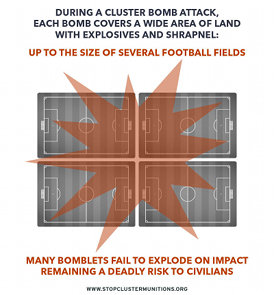What is a cluster bomb?
A cluster munition, or cluster bomb, is a weapon containing multiple explosive submunitions.
Cluster munitions are dropped from aircraft or fired from the ground or sea, opening up in mid-air to release tens or hundreds of submunitions, which can saturate an area up to the size of several football fields. Anybody within the strike area of the cluster munition, be they military or civilian, is very likely to be killed or seriously injured.

The fuze of each submunition is generally activated as it falls so that it will explode above or on the ground. But often large numbers of the submunitions fail to function as designed, and instead land on the ground without exploding, where they remain as very dangerous duds.
There are a wide variety of types of cluster munitions. According to the Cluster Munition Monitor, a total of 34 states have at one time developed or produced over 200 types of cluster munitions.
The definition under the Convention on Cluster Munitions
Under the Convention on Cluster Munitions, cluster munitions are defined and prohibited as a category of weapons. The definition of a cluster munition under Article 2 is "a conventional munition that is designed to disperse or release explosive submunitions each weighing less than 20 kilograms, and includes those explosive submunitions." Therefore the ban on cluster munitions, and all relevant Convention obligations such as stockpile destruction, apply both to the container and the submunitions it contains.
Sometimes explosive submunitions are not held within a container, but are released or dispersed by dispensers fixed to aircraft. The convention explicitly mentions that these weapons, known as explosive bomblets, are included under the ban.
Article 2 also defines what is not considered a cluster munition. Article 2(2)(a) and 2(2)(b) exclude a munition or submunition designed to dispense flares, smoke, pyrotechnics, or chaff, or designed to produce electrical or electronic effects. The definition also excludes "a munition designed exclusively for an air defence role," meaning a munition that can only be used against targets in the air. Weapons that are designed to have utility against both aerial and ground-based targets are banned. In addition, Article 1(3) states that the convention does not apply to mines, meaning it does not ban munitions that disperse one or more mines. (Antipersonnel mines are banned under the 1997 Mine Ban Treaty.)
Article 2(2)(c) lists the characteristics of a set of munitions with submunitions, the use of which is not believed to cause "indiscriminate area effects and the risks posed by unexploded submunitions." Any munition meeting all five of the criteria listed in Article 2(2)(c)(i-v) are not considered cluster munitions under the convention. Munitions meeting only four or less of the criteria are considered cluster munitions. For example, a munition that has less than 10 submunitions, but is not designed to detect and engage a single target object, is a cluster munition.
Delivery systems
Most delivery systems, be they warships, aircraft, artillery, or rocket launchers, can launch different types of munitions, including both banned cluster munitions and unitary munitions that are not banned. For this reason, the convention does not ban any delivery system, and States Parties therefore have no obligation to remove them from service or destroy them.
For more information
While the convention’s definition is straightforward, given the wide variety of munitions and submunitions that have been or may be developed, there still may be questions over whether individual weapon systems are banned. In this case, there are several places to find more information.
- States Parties and some signatories have already identified a wide variety of cluster munitions in their Article 7 reports and also presented in the Cluster Munition Monitor country profiles.
- The Geneva International Center for Humanitarian Demining (GICHD) has a web-based cluster munitions identification tool that helps identify unknown weapons and clarifies whether they fall under the convention.
- If the name of the weapon system is available, it may be possible to find out more about it from online weapons databases, such as those at the Federation of American Scientists, James Madison University’s ORDATA or Global Security.org.
- The CMC paper 'Cluster Munitions: A Banned Weapon' is a two-page guide on what a cluster munition is.



